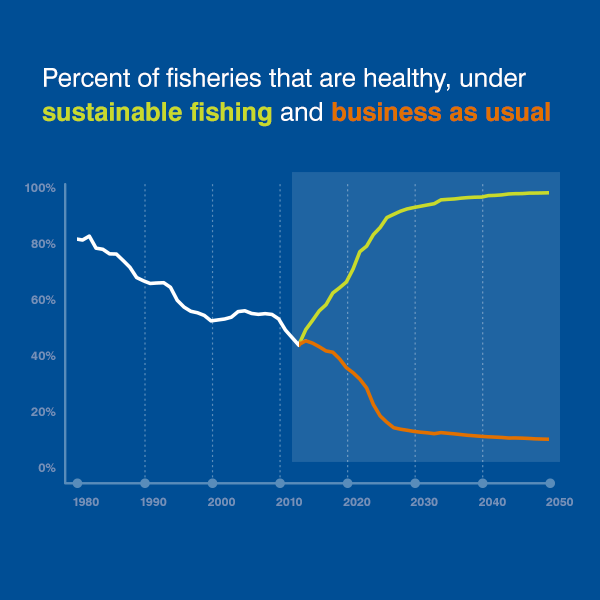Unlocking the potential of global fisheries
A new bio-economic model shows the great promise of sustainable fishing
The potential for recovering global fisheries has long been overlooked because the dominant view about the future of the oceans has been so bleak. That is about to change.
New groundbreaking research published in the Proceedings of the National Academy of Sciences shows the majority of the world's wild fisheries could be at healthy levels in just 10 years, and that global fish populations could double by 2050 with better fishing approaches compared to business as usual. A new "upside" bio-economic model, created by scientists and economists from the University of California Santa Barbara, the University of Washington and Environmental Defense Fund shows the potential of our ocean fisheries if sustainable fishing becomes the norm.

Compared to this "business-as-usual" scenario, the long-term potential of the oceans is even more striking: By 2050 sustainably managed fisheries could produce 16 million metric tons (or 29%) more wild fish, generate $53 billion USD (or 204%) more profits, and boost the amount of fish left in the water for conservation by 118%.
We face a stark choice: Manage fisheries sustainably or do nothing and watch the health of the oceans continue to decline.
What will it take to realize the tremendous potential of the world's oceans? The model suggests that the greatest economic improvements come from reforming institutions. A group of approaches collectively known as "fishing rights," such as cooperatives, territorial user rights, and individual transferable quotas, can increase profits quickly. That can help offset the costs of transitioning to sustainability.
The upside model shows great promise for the world's oceans and those who rely on them. Other insights include:
- Recovery can happen quickly. The model shows that fisheries can be made healthy again relatively quickly once fishing rights are put into place — even while fishing continues. According to the paper, if reforms were implemented today, three-quarters of exploited fisheries worldwide could attain population goals within ten years, and 98% by mid-century.
- Every major fishing nation stands to benefit. And even though management costs associated with sustainable fishing may rise, the benefits to nations from reforming fisheries always exceed the costs.
- Gains are even more dramatic when compared to the alternative. If nothing changes, fisheries will keep declining. When these downward trends are taken into account, the potential increase in the health and productivity of the oceans is even more dramatic.
This research is a call to action for governments, fishermen and investors. Within decades, a projected 9.5 billion increasingly affluent and urban people will compete for more food from maxed out resources.
If effective reforms to end overfishing were put in place today, the ocean could become a sustainable, highly productive source of wild seafood to help feed this growing population. The study shows how we can make this vision a reality.












